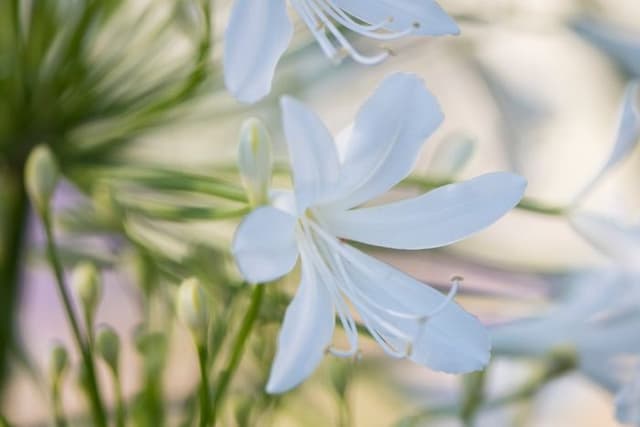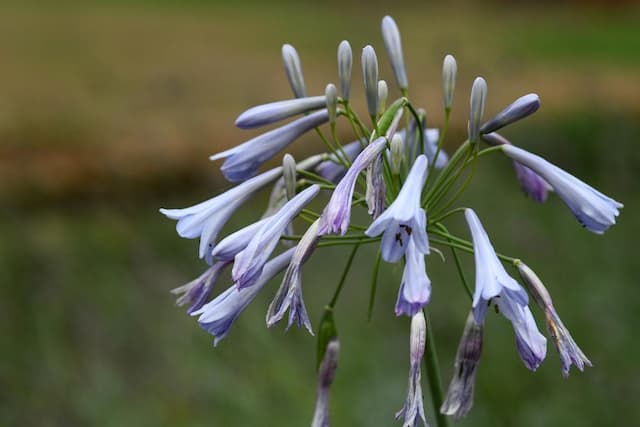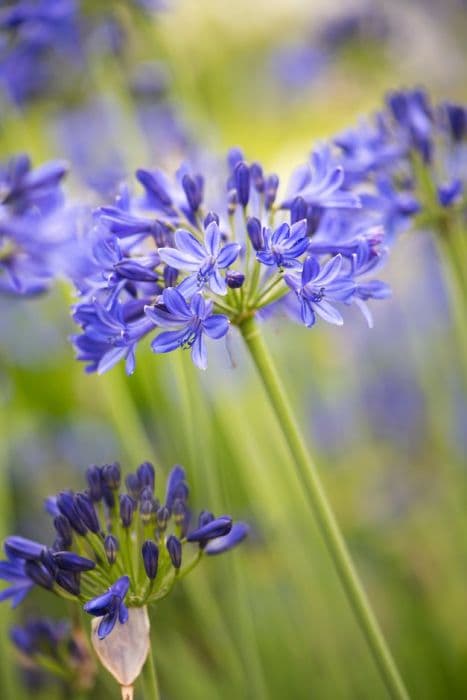Bell Agapanthus Agapanthus campanulatus

ABOUT
Agapanthus campanulatus, commonly known as the Bell Agapanthus, is a perennial plant notable for its striking floral display. It features dense clumps of long, slender, arching leaves that are glossy and dark green. Emerging from these leaves, sturdy, upright stems support the plant’s most captivating attribute: its flowers. The blooms are typically shaped like bells or funnels, arranged in large, rounded clusters at the end of each stem. The color of the flowers is usually a deep blue to violet, but can occasionally be found in shades of white. The Bell Agapanthus has a lush appearance and is often used in gardens and landscapes for its decorative flowers that provide a burst of color, which are especially alluring to pollinators such as bees and butterflies. The plant tends to bloom in the summer and makes a dramatic statement when planted in groups, forming a sea of blue-hued flowers.
About this plant
 Names
NamesFamily
Amaryllidaceae
Synonyms
Bell Agapanthus, African Lily, African Blue Lily, Love Flower
Common names
Agapanthus campanulatus.
 Toxicity
ToxicityTo humans
Agapanthus, commonly known as Lily of the Nile, contains toxic substances that can be harmful to humans if ingested. All parts of the plant are considered poisonous, particularly the sap and roots. If consumed, Agapanthus can cause symptoms such as nausea, vomiting, abdominal pain, and diarrhea. In some cases, it can also lead to dizziness and tremors. Skin contact with the sap may result in irritation or dermatitis in sensitive individuals. It is important to handle the plant with care and to seek medical attention if ingestion is suspected.
To pets
Agapanthus, or Lily of the Nile, is toxic to pets such as dogs and cats. All parts of the plant contain poisonous compounds, with the sap and roots being the most toxic. If a pet ingests Agapanthus, they may exhibit symptoms like vomiting, diarrhea, abdominal pain, and excessive drooling. In severe cases, ingestion can lead to lethargy, depression, and tremors. It is critical to prevent pets from accessing or chewing on this plant, and to consult a veterinarian immediately if ingestion is suspected.
 Characteristics
CharacteristicsLife cycle
Perennials
Foliage type
Evergreen
Color of leaves
Green
Flower color
Blue
Height
2 feet (60 cm)
Spread
2 feet (60 cm)
Plant type
Bulb
Hardiness zones
8
Native area
South Africa
Benefits
 General Benefits
General Benefits- Ornamental Value: Agapanthus campanulatus, commonly known as Bell Agapanthus, has striking blue or violet flowers that are highly decorative and are often used in ornamental gardens and as cut flowers.
- Drought Tolerance: The plant is adapted to survive in dry conditions, making it suitable for xeriscaping and low-water gardens.
- Coastal Gardening: Bell Agapanthus is tolerant of coastal conditions, including salt spray and sandy soils, making it ideal for seaside landscapes.
- Erosion Control: The thick roots of Agapanthus campanulatus help stabilize the soil, reducing erosion on slopes and embankments.
- Pollinator Attraction: The flowers of the plant attract pollinators like bees and butterflies, supporting local biodiversity.
- Low Maintenance: Once established, Bell Agapanthus requires minimal maintenance, making it a convenient choice for gardeners with limited time.
 Medical Properties
Medical Properties- This plant is not used for medical purposes.
 Air-purifying Qualities
Air-purifying QualitiesThis plant is not specifically known for air purifying qualities.
 Other Uses
Other Uses- Ornamental Display: Agapanthus, often known as African Lily, is commonly cultivated for its attractive blue, purple, or white flowers, which add a vibrant touch to gardens and landscapes.
- Border Plants: Due to their clumping nature and striking flowers, African Lilies are frequently used to create borders in gardens, providing a natural fence of lush foliage and blooms.
- Floral Arrangements: The long-lasting cut flowers of the Agapanthus make them a popular choice for floral arrangements and bouquets, adding both height and color.
- Container Gardening: African Lilies are well-suited for container gardening, making them ideal for balconies, patios, or areas with limited gardening space.
- Drought Resistance: In landscapes where water conservation is a priority, Agapanthus can serve as a suitable plant due to its ability to withstand periods of drought once established.
- Erosion Control: The robust root system of Agapanthus helps stabilize the soil, making it useful for planting on slopes or in areas prone to erosion.
- Cottage Gardens: Agapanthus' traditional appeal makes them a fitting addition to cottage-style gardens, where their informal beauty enhances the quaint charm of such settings.
- Seaside Gardens: The tolerance of Agapanthus to salty winds and sandy soil conditions makes them a good choice for gardens located near the coast.
- Pollinator Attraction: The nectar-rich flowers of Agapanthus attract a variety of pollinators, including bees, butterflies, and birds, thereby supporting local ecosystems.
- Seasonal Interest: With a blooming season that typically lasts from late spring to summer, African Lilies provide a burst of seasonal color when many other plants have yet to flower or have already finished blooming.
Interesting Facts
 Feng Shui
Feng ShuiThe African Lily is not used in Feng Shui practice.
 Zodiac Sign Compitability
Zodiac Sign CompitabilityThe African Lily is not used in astrology practice.
 Plant Symbolism
Plant Symbolism- Love Letters: The name "Agapanthus" is derived from the Greek words "agape" meaning love, and "anthos" meaning flower. Thus, it symbolizes a love letter or a message of love.
- Beauty: The striking blue to purplish flowers of the Agapanthus, commonly referred to as the African Lily, represent beauty and elegance in floristry and garden design.
- Enduring Love: African Lilies are often associated with enduring or lasting love due to their robust nature and the longevity of their blooms.
- New Beginnings: Given that they bloom at the start of the summer, Agapanthus can symbolize new beginnings or the start of a new adventure or journey.
 Water
WaterThe Agapanthus, commonly known as the African Lily, should be watered regularly during its active growth period in spring and summer, aiming at keeping the soil evenly moist but not waterlogged. Typically, watering once a week with about 1 to 1.5 gallons of water is adequate, but this can vary depending on climate conditions, with hotter, drier climates requiring more frequent watering. Reduce watering in the fall and further in winter to every few weeks, providing just enough water to prevent the soil from completely drying out. It is crucial to ensure good drainage to avoid root rot.
 Light
LightAfrican Lilies thrive best in full sun to partial shade conditions. They should be placed in a spot where they receive at least 6 hours of sunlight daily. Partial shade is especially beneficial during the hottest part of the day in very warm climates to prevent leaf scorch.
 Temperature
TemperatureAfrican Lilies are hardy plants, but they prefer a temperature range between 50°F and 80°F. They can tolerate a little frost down to about 28°F but should be protected or brought indoors if colder temperatures are expected. During their active growing phase in spring and summer, keeping them in their ideal temperature range ensures healthy growth.
 Pruning
PruningPrune the African Lily primarily to remove spent flower stalks and any damaged or dying foliage, which encourages new growth and a tidier appearance. Pruning is best done in early spring or after flowering. Regular deadheading of old flowers during the blooming season can also promote additional blooms.
 Cleaning
CleaningAs needed
 Soil
SoilAfrican lily thrives in well-draining, fertile soil with a pH ranging between 6.0 and 8.0. A good soil mix consists of two parts loam, one part perlite or grit, and one part compost. This composition ensures adequate drainage while retaining enough nutrients for optimal growth.
 Repotting
RepottingAfrican lily should be repotted every 3-4 years or when it becomes root-bound. Replanting in spring allows the plant to establish in the new container before the growing season.
 Humidity & Misting
Humidity & MistingAfrican lily prefers moderate humidity levels but it is quite adaptable and can tolerate the lower humidity conditions typically found in home environments. No specific humidity range is required for this hardy plant.
 Suitable locations
Suitable locationsIndoor
Grow African lily indoors in bright light with good air circulation.
Outdoor
Plant African lily in sunny spot with well-draining soil.
Hardiness zone
7-11 USDA
 Life cycle
Life cycleAgapanthus campanulatus, commonly known as Bell Agapanthus, starts its life cycle from seed, which upon germination grows into a seedling with characteristic thin, strap-like leaves. The plant then enters a vegetative stage where it develops a strong root system and foliage, gradually forming clumps. As it matures, Bell Agapanthus initiates the flowering stage, producing tall stalks topped with clusters of bell-shaped blue or white flowers during summer. After pollination, often by insects, the flowers develop into capsule-like fruit, which when ripe, release the seeds, thus completing the reproductive cycle. In regions with colder climates, the plant may die back in the winter only to resprout from its rhizomes with the arrival of spring. With adequate care, Bell Agapanthus can live for many years, repeating this cycle seasonally.
 Propogation
PropogationPropogation time
Spring to early summer
The most popular method of propagation for Agapanthus campanulatus, commonly known as the Bell Agapanthus, is through division. This is best done in the spring just before the growing season begins. To propagate by division, you should carefully lift the plant from the ground and gently separate the clumps of roots into smaller sections, each with at least one or two growing points. These individual clumps can then be immediately replanted into well-draining soil, watering them thoroughly to help establish the roots. Within a few weeks, these new plants will begin to grow and multiply, eventually maturing into blooming specimens of Bell Agapanthus.







![African lily [Brilliant Blue]](/_next/image?url=https%3A%2F%2Fplants-admin.emdemapps.com%2Fimages%2Fplants%2F%2Fimages%2F604b5e3c28e2b.png&w=640&q=75)

